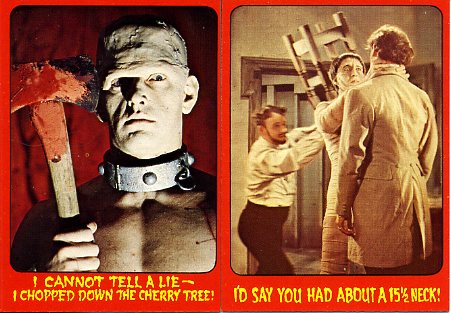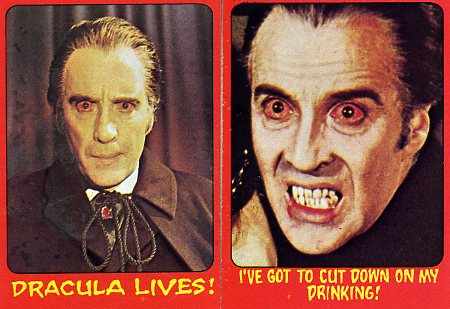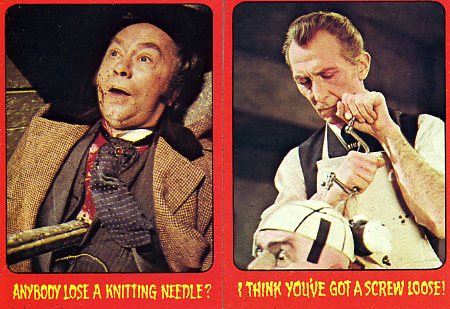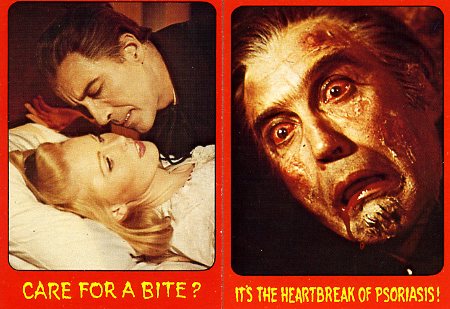Hammering Out Shock Theater!
By Kurt Kuersteiner © 2010Monsterwax
Monster Trading Cards
Considering all the articles written about monster cards in The Wrapper, it's hard to believe that none of them were about Shock Theater. It is, after all, the only Topps card set devoted to the infamous Hammer horror films, which are considered some of the best horror movies ever made. They were the first to bring blood-curdling color to horror, and they made Peter Cushing and Christopher Lee (haunted) household names.
Hammer films started in the 1930s in London, but in 1955, they produced The Quatermass Experiment and began a long and successful association with monsters. 1957 saw the full color release of Curse of Frankenstein . Peter Cushing played Doctor Frankenstein, and Christopher Lee played his towering monster. It was a giant success and six sequels followed through 1974. Hammer got away with rebooting Frankenstein without getting sued by Universal , but things would be dicier if they tried the same thing with Dracula. However, Universal was so impressed with Hammer's treatment of Frankenstein, they agreed to let Hammer produce a color version of Dracula in exchange for the distribution rights. Again, Cushing and Lee co-starred (as Doctor Van Helsing and Count Dracula, respectively). The resulting hit spawned eight sequels! Universal liked making good money while letting Hammer do all the work, and so they agreed to let Hammer recreate other classic monster characters as well, including the Mummy, the Phantom of the Opera, Dr. Jekyll, the Wolfman, and the Invisible Man. This successful partnership lasted over two decades, and entertained a new generation of bat-boys and their ghoul friends at drive-ins throughout America.
The secret to Hammer's success was spending time on refining the script, using quality (but cheaper) actors and crew, and organizing everything ahead of time to maximize efficiency and reduce costs. It's a lesson Hollywood seems incapable of learning, even to this day. As a result, Hammer films were not only more coherent than most American monster movies, they also looked lavish and made big profits.
How Topps wound up with a license to produce a British monster set is uncertain, but it is possible a connection was made via A&BC, the distribution company that printed Topps cards in England for many years until it ended in legal disputes. (It was A&BC that lined up The Beatles series for Topps a decade earlier, which were big money makers for both companies.) That partnership was the reverse of Universal with Hammer's, because it was Topps that did the artistic work and A&BC printed and distributed the product in the UK.
Shock Theater cards are visually stunning. The fronts have bright red borders with gags written beneath full color photos. The images feature Hammer's version of Dracula, Frankenstein, and in one card (#50 of the test set), the Mummy. The backs are similar to You'll Die Laughing, but with a different monster graphic and different jokes. There is also a credit line at the bottom with a serious comment about the front and identifying which film it is from.

The US test version (1975): David Prowse with an ax, and Christopher Lee as the Mummy.
Two different series of Shock Theater were released; an American test series © 1975, and a British regular series (with the British spelling of Theatre) © 1976. Both versions were "American size" (2.5" x 3.5"). Many of the images were identical as well, although the US test set has more photos from the various Frankenstein movies (14, compared to the British set, which only has 4. Most are of David Prowse, aka Darth Vader.) Four of the photos in the test set have different jokes in the UK version. #14, for example, features Christopher Lee as Dracula reaching out to a young blond in her nightgown. The US version says, "Not tonight dear... I have a headache," whereas the UK version has a less suggestive line, "Dear, your finger nails are a disgrace!" Card #17, 32, and 34 also use identical images with different gags.

The regular English version (1976). Christopher Lee glares as Dracula.
Perhaps the strangest joke of all is that card #47 is missing in the American test set. Instead, there are two #17s (one of them with the same photo but a different gag from its British counterpart). To make matters more confusing, card #17 of the British version is missing, but there is an extra #47! Could this be a subtle homage to the one Universal classic Hammer agreed to remake but never did: The Invisible Man? (Nah-- that's giving Topps way too much credit!)
But what if these mistakes were not really mistakes? What if they were intentional?
"Blasphemy!" you shriek, "It makes no sense! Why would they do such a thing?" Well, the most obvious reason would be increased sales. It wouldn't be the first time Topps tweaked the card breakdown to make kids buy more packs. Granted, finding a living witness that can testify to this conspiracy is difficult. (Topps was based in Brooklyn and had plenty of nearby Mafia to rub out such snitches!) But that doesn't mean there are no smoking guns.
Enter Exhibit A: Wrapper reader Matt Kirscht recently bought an uncut sheet of Shock Theatre 1976 from Topps Vault on eBay and it revealed some interesting insights. For starters, there were 132 cards on the sheet. But rather than have two complete sets with 32 extras, Topps stacked the deck to insure collectors were stuck with big piles of certain dupes and much fewer of others. 28 of the cards have two duplicates on the sheet, while 18 of them have three dupes. Cards #1, 15, & 18 have five duplicates, and card #40 has seven! These four big piles of dupes may have been an attempt to steer collectors into thinking it was only a distribution problem.
Now, I know what you're thinking: "So what? If they really wanted to make it difficult, they would have single-printed some cards instead of having two sets on every sheet." Ah, but Topps already tried that with other series, and although it's clever and boosted sales, it was evil genius to skip a number in both series, because frustrated collectors would keep buying more packs to finish their sets, not realizing that completing them was impossible.
Think about it. The Wrapper wouldn't exist for another two years, and the internet wouldn't come along for nearly a decade. Who was going to alert buyers that a certain number didn't even exist? There was very little communication between card collectors back then. Everyone was pretty isolated and had to discover the hard way that they were wasting their money buying more packs. So call me crazy if you want, but I believe it was Topps acting crazy. Crazy like a fox!
One screw up in the US test set that is beyond comprehension is the inclusion of an additional card. There are 51 cards instead of 50 in the set, and no checklist. What makes it especially funny is that the card is actually numbered #51. You would think that if you were producing a fifty card series, having #51 printed on a card would be a rather obvious red flag that something is wrong! (But maybe that's just me.) At least the British version got the number of cards in the set right, with both the last card labeled #50 and exactly 50 cards in the set.
Another interesting thing about Matt's sheet is that the cardstock reverse is cream colored, instead of the gray color back more commonly seen in the regular release. Was this a proof sheet or just a "make ready" sheet that came off the press during a later printing? (Your guess is as good as mine.) It's also interesting that the sheet is the UK version sold by Topps Vault (in the USA). The partnership between Topps and the A&BC company ended in 1974, after Topps took them to court and won. I don't know if Topps was printing the British cards and shipping them to England, or using the old A&BC equipment to run them off in England, but by 1975, all the design work must have been done in house in the USA. It also explains why this series is American size (unlike the smaller sized cards A&BC usually printed for Topps). This is one of the first non-sports sets released by Topps after forcing the old A&BC owners out.
All in all, there are about 20 cards with different photos that distinguish the two series from one another. (The easiest way to tell the two apart is by checking the copyright date on the back. It's ©1975 on the US cards, and ©1976 on the UK cards.) Another difference between the two is the price. The American test version usually costs about $500, whereas the British version is usually around $200. The US test set is super expensive because of its scarcity. (Test cards are only marketed in a few cities.) The British version, on the other hand, is pricey (compared to other 1970s sets) because of the demand. No doubt the British have a special fondness for their homegrown horror movies, while American collectors also drove up the price by buying sets from across the pond.

Scenes from both versions. Stratford Johns suffers heartburn. Peter Cushing drills a corpse.
Shock Theater was the first full color monster photo series released by Topps and remains one of the most unusual. The colors are mesmerizing and unlike the You'll Die Laughing photo-cards, none of the actors had their heads swapped out with Topps employees! The super serious descriptions (beneath the jokes) are a nice touch, too. My favorite is card #49, which states, "There is only one cure for vampirism... a stake through the heart! Scientists have long sought a medical cure for this vile affliction, but to no avail." (These must be the same scientists who are curing our planet of Global Warming with new forms of energy. They always seem really busy but have nothing to show for it!)
My only criticism of Shock Theater is that it is practically all vampires, at the expense of other monsters, like the Frankenstein monster, the mummy, the Phantom of the Opera, or better yet, the hairy chested wolfman from The Curse of the Werewolf (a photo of which made it into You'll Die Laughing (see #34) series two years earlier. Hammer filmed them all, so licensing was certainly possible. And you have to admit, when it comes to make-up, a pair of fangs and blood around the lips is kind of lame. Then again, the vampire cards tend to include a lot more pictures of sexy women (with lots of hickies). So there are definitely pros and cons.
Shock Theater may not be the best monster series ever made, but I can't think of any better ones that came out of the 1970s or 80s. (Can you?) Why it didn't test better in the USA is speculative, but I would imagine it was because the movies themselves were off limits to the kids who made up the bulk of American card collectors at the time. Unlike the Universal monster movies that appeared on TV during the 1950s/60s, Hammer films were rated X and didn't make it to TV for a long time. Card collecting has always been more serious in England, however, and finding a large adult audience who collected cards and watched gory monster movies would have been a lot easier there.
Whatever the reason, we can thank our friends across the Atlantic for getting a much cheaper version of this cool set on the market. If you like vintage monster cards but can't afford the US test version of Shock Theater, then you can still snag its UK cousin. Like the Hammer monster movies it depicts, the British version may not be the original, but is just as good for less money!
More scenes from both versions: Lee nibbles on a lady and later, sees the sun.
